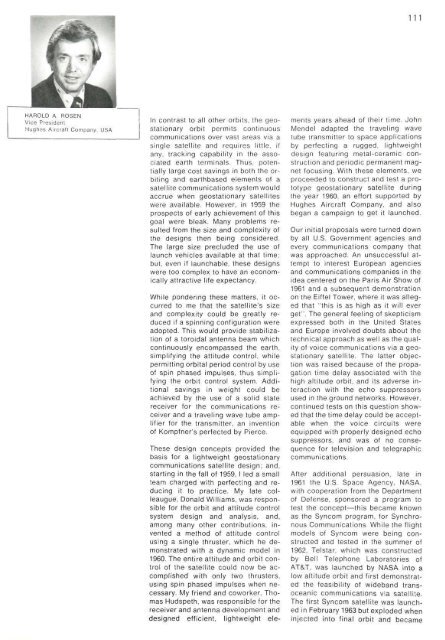geostationary telecommunications satellites electronic telephone set ...
geostationary telecommunications satellites electronic telephone set ...
geostationary telecommunications satellites electronic telephone set ...
You also want an ePaper? Increase the reach of your titles
YUMPU automatically turns print PDFs into web optimized ePapers that Google loves.
111<br />
HAROLD A. ROSEN<br />
Vice President<br />
Hughes Aircraft Company, USA<br />
In contrast to all other orbits, the <strong>geostationary</strong><br />
orbit permits continuous<br />
communications over vast areas via a<br />
single satellite and requires little, if<br />
any, tracking capability in the associated<br />
earth terminals. Thus, potentially<br />
large cost savings in both the orbiting<br />
and earthbased elements of a<br />
satellite communications system would<br />
accrue when <strong>geostationary</strong> <strong>satellites</strong><br />
were available. However, in 1959 the<br />
prospects of early achievement of this<br />
goal were bleak. Many problems resulted<br />
from the size and complexity of<br />
the designs then being considered.<br />
The large size precluded the use of<br />
launch vehicles available at that time;<br />
but, even if launchable, these designs<br />
were too complex to have an economically<br />
attractive life expectancy.<br />
While pondering these matters, it occurred<br />
to me that the satellite's size<br />
and complexity could be greatly reduced<br />
if a spinning configuration were<br />
adopted. This would provide stabilization<br />
of a toroidal antenna beam which<br />
continuously encompassed the earth,<br />
simplifying the attitude control, while<br />
permitting orbital period control by use<br />
of spin phased impulses, thus simplifying<br />
the orbit control system. Additional<br />
savings in weight could be<br />
achieved by the use of a solid state<br />
receiver for the communications receiver<br />
and a traveling wave tube amplifier<br />
for the transmitter, an invention<br />
of Kompfner's perfected by Pierce.<br />
These design concepts provided the<br />
basis for a lightweight <strong>geostationary</strong><br />
communications satellite design; and,<br />
starting in the fall of 1959, I led a small<br />
team charged with perfecting and reducing<br />
it to practice. My late colleaugue,<br />
Donald Williams, was responsible<br />
for the orbit and attitude control<br />
system design and analysis, and,<br />
among many other contributions, invented<br />
a method of attitude control<br />
using a single thruster, which he demonstrated<br />
with a dynamic model in<br />
1960. The entire attitude and orbit control<br />
of the satellite could now be accomplished<br />
with only two thrusters,<br />
using spin phased impulses when necessary.<br />
My friend and coworker, Thomas<br />
Hudspeth, was responsible for the<br />
receiver and antenna development and<br />
designed efficient, lightweight elements<br />
years ahead of their time. John<br />
Mendel adapted the traveling wave<br />
tube transmitter to space applications<br />
by perfecting a rugged, lightweight<br />
design featuring metal-ceramic construction<br />
and periodic permanent magnet<br />
focusing. With these elements, we<br />
proceeded to construct and test a prototype<br />
<strong>geostationary</strong> satellite during<br />
the year 1960, an effort supported by<br />
Hughes Aircraft Company, and also<br />
began a campaign to get it launched.<br />
Our initial proposals were turned down<br />
by all U.S. Government agencies and<br />
every communications company that<br />
was approached. An unsuccessful attempt<br />
to interest European agencies<br />
and communications companies in the<br />
idea centered on the Paris Air Show of<br />
1961 and a subsequent demonstration<br />
on the Eiffel Tower, where it was alleged<br />
that "this is as high as it will ever<br />
get". The general feeling of skepticism<br />
expressed both in the United States<br />
and Europe involved doubts about the<br />
technical approach as well as the quality<br />
of voice communications via a <strong>geostationary</strong><br />
satellite. The latter objection<br />
was raised because of the propagation<br />
time delay associated with the<br />
high altitude orbit, and its adverse interaction<br />
with the echo suppressors<br />
used in the ground networks. However,<br />
continued tests on this question showed<br />
that the time delay could be acceptable<br />
when the voice circuits were<br />
equipped with properly designed echo<br />
suppressors, and was of no consequence<br />
for television and telegraphic<br />
communications.<br />
After additional persuasion, late in<br />
1961 the U.S. Space Agency, NASA,<br />
with cooperation from the Department<br />
of Defense, sponsored a program to<br />
test the concept—this became known<br />
as the Syncom program, for Synchronous<br />
Communications. While the flight<br />
models of Syncom were being constructed<br />
and tested in the summer of<br />
1962, Telstar, which was constructed<br />
by Bell Telephone Laboratories of<br />
AT&T, was launched by NASA into a<br />
low altitude orbit and first demonstrated<br />
the feasibility of wideband transoceanic<br />
communications via satellite.<br />
The first Syncom satellite was launched<br />
in February 1963 but exploded when<br />
injected into final orbit and became
















